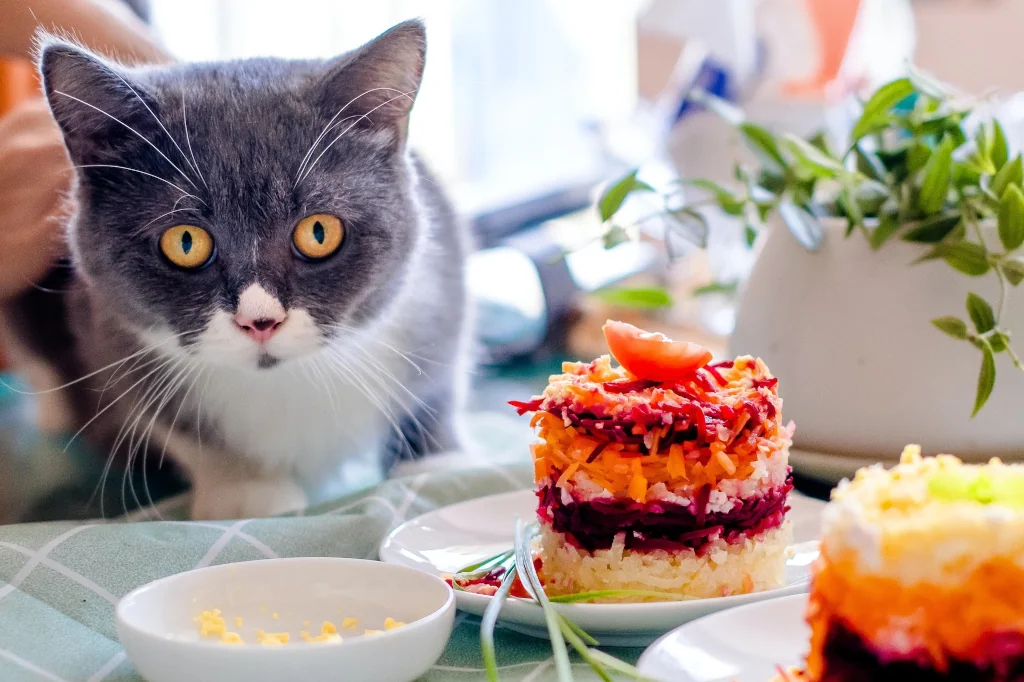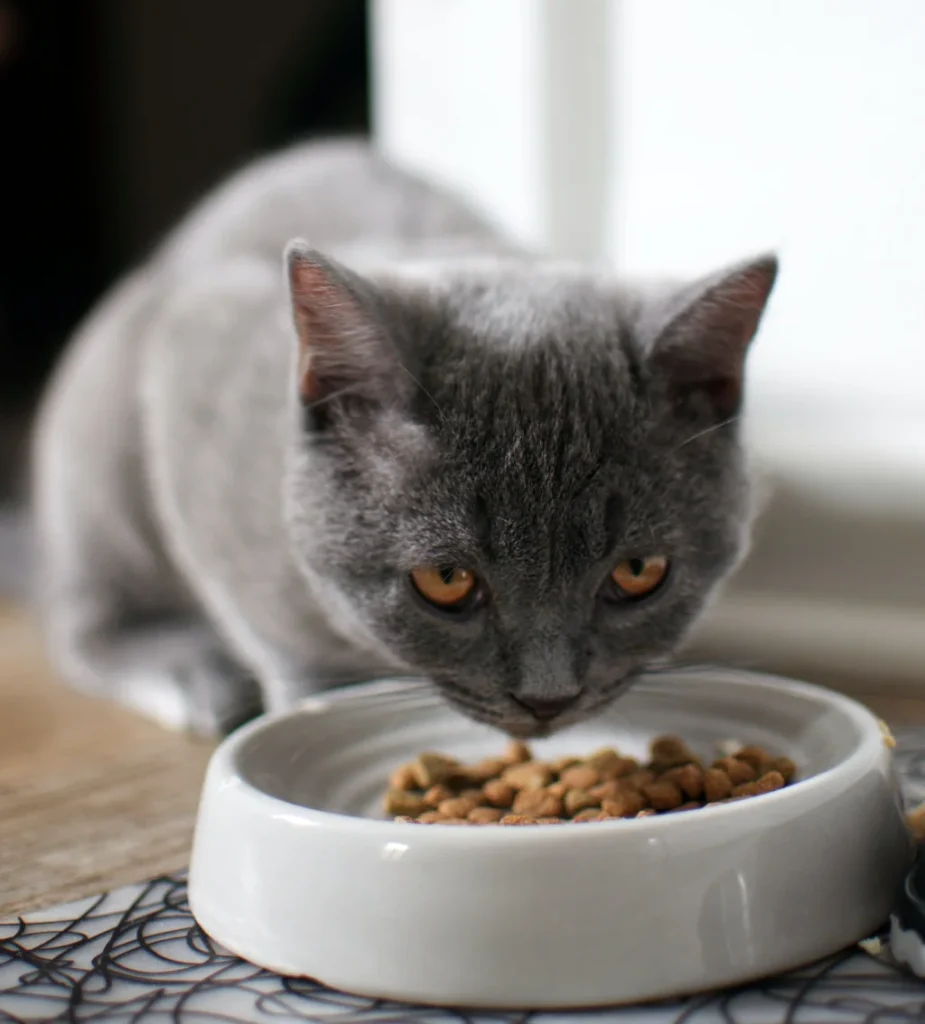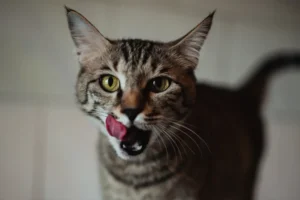Disclosure: We may earn a commission from helpful, relevant links in our content. No cost to you. See our privacy policy.
Cat food conundrums, right? It’s that ever-pressing question: wet or dry?
You’re always striving to provide your fur baby with the best, but it can be tough to sift through the copious amount of conflicting advice out there.
One week, wet food is the cat’s meow, and the next, dry food reigns supreme. You want to keep your feline friend’s purrs rumbling but also need to ensure their health is top-notch.
In this blog post, we’re going to go whisker-deep into the pros and cons of both wet and dry cat food. We aim to guide you through this sea of information, providing valuable insights to make your next mealtime decision less of a guessing game and more of an informed choice.
Get ready to become the feline foodie your cat thinks you are!

Wet Cat Food Pros and Cons
Ah, the allure of a tin can opening – it’s music to any cat’s ears.
Wet cat food, with its delicious aroma and moist texture, is often the star of many cat commercials. But what lies beyond the enticing sheen of the can’s cover? Let’s uncover the pros and cons of wet cat food.
Pros:
- Hydration Hero. Wet cat food contains about 70-80% water. This can be a great way to keep your kitty hydrated, especially for those who aren’t keen on drinking from their water bowl.
- Protein Power. Wet food often contains higher amounts of animal protein and fewer carbs, aligning well with a cat’s natural diet.
- Tastier Treat. Many cats find wet food more palatable due to its texture and aroma, encouraging picky eaters to chow down.
Cons:
- Perishable Pate. Once opened, wet cat food doesn’t last long and should be eaten within hours.
- Dental Dilemma. Wet food doesn’t provide the abrasive action like dry food to help clean teeth, potentially leading to oral health issues.
- Hefty Price. Generally, wet food is more expensive than dry, which could be a consideration for multi-cat households.
The nuances of wet cat food are many, and while it shines in hydration and satiating picky eaters, it falls short in dental care and shelf-life. All factors considered, wet cat food serves as a healthy and flavorful choice, particularly for cats who are poor drinkers or require high protein intake.
Suggested high-quality wet cat food: Hill’s Science Diet Wet Cat Food, Adult, Urinary & Hairball Control. It not only offers balanced nutrition but also assists in urinary health and controls hairball formation.
In the next section, we’ll dive into the world of dry cat food, comparing its advantages and disadvantages, and helping you decide what’s best for your furry companion.
Related: Guide to Choosing Wet Cat Food
Dry Cat Food Pros and Cons
In the other corner of the ring, we have the stalwart of pet food aisles everywhere: dry cat food. Convenient, crunchy, and easy to portion – but how does it measure up nutritionally? Let’s put dry food under the microscope.
Pros:
- Convenience King. Dry food is easy to portion, store, and it doesn’t spoil quickly, making it a convenient option for busy cat parents.
- Dental Bonus. The abrasive texture of dry food can help clean your cat’s teeth as they chew, potentially aiding in oral health.
- Wallet-Friendly. Typically, dry food is less expensive than wet food, making it an economical choice for many households.
Cons:
- Hydration Hurdle. With a moisture content of just 6-10%, dry food might not be the best choice for cats who don’t drink much water.
- Carb Question. Dry food can be higher in carbohydrates, which is not ideal for cats who are obligate carnivores by nature.
- Palate Problem. Some cats may find dry food less palatable due to its lack of aroma and hard texture.
Dry cat food, with its convenience and dental benefits, stands tall in its corner. However, it falters on the hydration front and may not always entice your cat’s palate. Given its ease of storage and budget-friendliness, dry cat food can be an ideal pick for busy households and multi-cat families.
Suggested high-quality dry cat food: Blue Buffalo Wilderness High Protein. This high-protein, grain-free recipe mirrors a cat’s natural diet and supports overall health, including heart, eye, and fur health.
In the next section, we’ll be turning the spotlight on a side-by-side comparison of wet and dry food, providing a more detailed look to help you find the purr-fect fit for your feline friend.

Detailed Comparison: Dry vs Wet
Nutritional Content
The nutritional composition is a significant factor when comparing wet and dry cat food.
Typically, wet food provides more protein and fewer carbohydrates, closely resembling the natural diet of a wild cat. Dry food, however, can sometimes be packed with more plant-based ingredients and carbs due to the manufacturing process.
Still, many high-quality dry foods also offer balanced nutrition suitable for cats. Always look for food that adheres to AAFCO (Association of American Feed Control Officials) standards for a nutritionally balanced meal.
Given its high protein and low carb profile, the trophy in the nutrition race goes to wet cat food. It mimics a cat’s natural diet more closely, making it a more biologically appropriate choice.
Winner on Nutrition: Wet Cat Food.
Hydration
Cats are known for their low thirst drive, which has its roots in their desert-dwelling ancestors.
Wet cat food, with its high moisture content, can be a useful tool for keeping your kitty hydrated. Dry food, with its minimal water content, relies more heavily on your cat drinking adequate water throughout the day.
With its high moisture content, wet cat food is a hydration hero, especially for cats who may not drink enough water independently. It’s a clear winner in keeping your cat well-hydrated.
Winner on Hydration: Wet Cat Food.
Oral Health
Many believe that dry food’s crunchy texture aids in keeping your cat’s teeth clean by reducing plaque buildup, while wet food does not offer this benefit.
However, this is a topic of debate among veterinarians. If dental health is a concern, specific dental health foods, regardless of being wet or dry, are recommended.
Although this is still a topic of debate among vets, dry food, with its crunchy texture, offers an additional line of defense against dental problems. For its potential plaque-reducing benefits, the oral health crown goes to dry food.
Winner on Oral Health: Dry Cat Food.
Ease of Storage and Cost
Dry food unquestionably reigns in this department. It’s non-perishable, easy to store, and usually easier on the wallet. Wet food, while being a favorite among cats, needs refrigeration once opened and generally comes with a higher price tag.
The crown for convenience and cost-effectiveness is undeniably claimed by dry food. Its longer shelf-life and affordability make it a practical choice for many cat parents.
Winner on Storage & Cost: Dry Cat Food.
Palatability
Often, cats show a preference for one over the other. Wet cat food tends to be more palatable due to its aroma and texture. However, every cat is an individual, and taste preferences can vary significantly.
Overall, due to its enticing aroma and texture, wet food generally takes the victory in the palatability department. However, this can vary with individual cat preferences.
Winner on Palatability: Wet Cat Food (but subject to your cat’s personal taste).
Final Verdict: A Balanced Mix?
You’d like a definitive answer about one cat food being better than the other, as it would make it easier, wouldn’t it?
But, in all honesty, in the wet versus dry cat food debate, the reality is there’s no one-size-fits-all answer. Every feline is unique, with distinct dietary needs and preferences, and both types of food have their own pros and cons in various aspects.
So what’s the final verdict?
A blend of both types could offer the benefits of each. The high moisture content of wet food keeps your cat hydrated and satisfied, while dry food offers dental benefits and convenience.
Most importantly, consult with your vet to determine the best diet that meets your cat’s specific health needs and lifestyle. Remember, balance and moderation are key.
Related: Guide to Cat Food Ingredients
Interactive Quiz: Discover Your Cat’s Preferred Food
This quiz will help you decide which type of food – wet or dry – might suit your feline friend better. The questions will focus on your cat’s unique characteristics and behaviors, such as their drinking habits, dental health, and preferences. Remember, these results are meant to serve as a general guide and may not replace professional veterinary advice. Let’s get started!
Question 1: What is your cat’s age?
KittenAdult
Senior
Which One Does Your Cat Prefer: Dry or Wet?
Most cats prefer wet food because of it’s strong aroma, but it’s not always the case.
To find out whether your feline friend prefers wet or dry food, consider doing a little taste test. Offer them small servings of both types and observe which one they gravitate towards.
Remember that transitioning from one type to another should be done gradually to avoid upsetting your cat’s stomach. Also, since cats are creatures of habit, any drastic changes can stress them out.
Our unique tip? Pay attention to the time of day you’re feeding wet or dry food. Some cats might prefer a juicy, wet meal in the evening, reminiscent of a successful ‘hunt’, while having crunchy, dry kibbles through the day.
The great cat food debate need not turn into a battlefield. Take into account your cat’s health, age, lifestyle, and preference, then make an informed decision. Don’t hesitate to consult with your vet if you’re unsure. After all, a happy cat equals a happy cat parent.
Glossary of Terms
- Obligate Carnivores: Animals that require a primarily meat diet.
- AAFCO: An organization that sets standards for pet food in the US, ensuring nutritional adequacy.
- Hydration: The process of providing an adequate amount of water.
- Palatability: Refers to the taste and texture of the food.
FAQs
Can feeding my cat only wet food cause problems?
Feeding your cat only wet food can potentially lead to dental issues, as wet food doesn’t provide the abrasive action against the teeth that dry food does. A study has found that cats who ate some dry food had less dental plaque and tartar on their teeth.
Can I mix dry and wet cat food together?
You certainly can mix dry and wet cat food together. This can provide a balanced diet, combining the hydration benefits of wet food and the dental advantages of dry food.
How long can wet cat food stay out?
Wet cat food, once opened, should not stay out for more than four hours. After this period, bacteria can start to grow, making the food unsafe for your cat to eat. Always refrigerate any uneaten portion.
What if my cat only likes one type of food?
If your cat only likes one type of food, it’s fine to feed them just that, provided it’s nutritionally balanced. However, introducing a variety can be beneficial as it exposes your cat to different textures and flavors and may prevent them from becoming a picky eater.
What if my cat has dietary restrictions or allergies?
If your cat has dietary restrictions or allergies, you’ll need to choose a cat food that suits their specific needs. There are various specialty diets available for cats with sensitivities, including grain-free, limited ingredient, and prescription diets.
Alex, a passionate animal lover, has experience in training and understanding animal behavior. As a proud pet parent to two dogs and three cats, he founded AnimalReport.net to share insights from animal experts and expand his knowledge of the animal kingdom.




